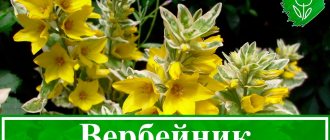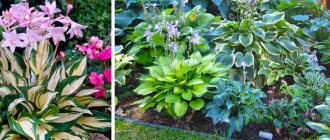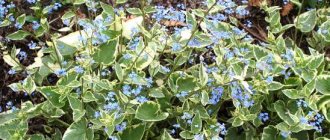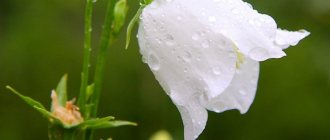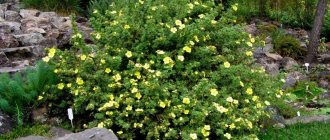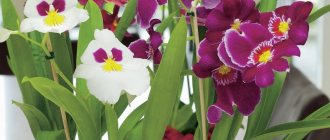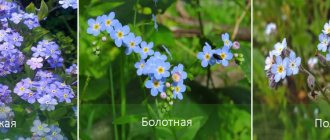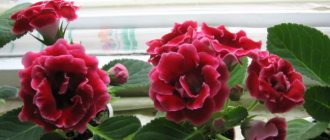Herbaceous loosestrife may not be the brightest decoration in the garden, but its pickiness and resistance to adverse external factors have made it a real favorite among gardeners.
In addition, the lysimachia flower (another version of the name is lysimachia) fits perfectly into rockeries and is suitable for an alpine slide , which allows it to be used in the formation of even complex compositions.
Description
The loosestrife received its name due to the striking similarity of its leaf blades to the leaves of the willow. scientific name “lysimachia” in honor of the commander of Alexander the Great, Lysimachus , who later became the king of Macedonia and the ruler of Thrace.
Lysimachia belongs to the Primrose family, and the genus has about a hundred varieties, which are divided into cultivated and wild.
Among this diversity there are both annual and biennial plants, as well as perennial plants , flowers with erect shoots and a creeping bush; The shapes of the leaf blades and the types of inflorescences also differ. Representatives of the genus are known with lush, voluminous flower panicles and with single flowers.
But the loosestrife cannot boast of a variety of colors.
Main petal colors:
- shades of yellow;
- pink;
- white.
The natural range of lysimachia is extensive:
- Russia;
- northern regions of America;
- North Africa;
- China;
- territories of East Asia;
- Caucasus.
Varieties of flowers with photos
Of the almost 100 varieties of lysimachia, these flowers are the most popular in gardening.
Common loosestrife (Lysimachia vulgaris)
This tall plant is native to the northern regions of Africa, but is also found in Eurasia. Prefers marshy meadows and lowlands, wet forest glades and river banks . The height of the shoots can vary from half a meter to one meter.
The plant has a creeping developed rhizome, dense, whole-cut elongated leaf plates with a sharp tip. The leaves, which are smooth on the outside, have obvious pubescence on the underside.
The flowers, in their outlines, resemble bright yellow bells with a small brown spot at the base of the petals. The flowers are a good honey plant and form a paniculate apical inflorescence.
Interesting! This variety of lysimachia can be grown in shallow reservoirs up to 0.1 m deep, since its roots are not afraid of prolonged contact with moisture.
Loosestrife (Lysimachia nemorum)
This relatively small perennial plant reaches only 0.3 m in height. It is distinguished by large leaf blades and single yellow flowers.
Found in Europe and the European part of Russia, it prefers to live on the banks of streams and rivers, but is also found even in subalpine meadows.
Loosestrife (Lysimachia thyrsiflora, also known as snork)
You can meet this fairly tall flower in the shallow waters of streams and small reservoirs. The height of the erect stem slightly exceeds the half-meter mark. The leaf blades have a narrow lanceolate shape.
Small fluffy yellow-green flowers forming axillary inflorescences attract attention due to the stamens sticking out in all directions.
Loosestrife (Lysimachia punctata)
In its natural environment, this lysimachy can be found in the forests of Europe.
The erect shoots of loosestrife have obvious pubescence, the leaves are wide, with a pronounced lanceolate shape. Lemon-yellow corollas are located on the slightly branched crown.
Lily of the valley (Lysimachia clethroides) or clethroid loosestrife
You can find this plant in the Primorsky Territory. The rhizome of the plant resembles the root of a lily of the valley in shape, only denser and longer, colored light pink.
The height of the pubescent, vertically oriented shoots can reach 20 cm. Small white flowers form a spike-shaped inflorescence.
Interesting! The length of the inflorescence can be equal to the length of the stem of the loosestrife.
Monetary/coin loosestrife (Lysimachia nummularia, meadow loosestrife or meadow tea)
In nature, such a plant can be found on the territory of the Japanese Islands, in Europe and North America. This perennial groundcover creeping plant prefers floodplain meadows, coastal areas of reservoirs and stream banks.
The length of the shoots can reach 30 cm, and given their number, the bush takes up enough space. There is no pubescence on the shoots, and small, oppositely located rounded leaf plates resemble coins in outline.
The flowers are bright yellow, solitary, axillary, their diameter can reach 2.5 cm.
Purple loosestrife (Lysimachia purpurea) or ciliated loosestrife (Lysimachia ciliata)
It is endemic to North America. Vertically oriented shoots are slightly less than half a meter in height.
The wide, pointed leaves of loosestrife have an attractive purple-wine hue. Small axillary yellow flowers form loose inflorescences.
Attention! To maintain the decorative appearance of the plant, it requires quite a lot of sunlight.
Black-purple loosestrife (Lysimachia atropurpurea)
In its natural environment, this loosestrife is found in Greece. The height of the shoots can vary from half a meter to 0.9 m.
The plant is remarkable for its large spike-shaped inflorescences formed by a large number of buds of a rich wine color. A small wave is visible along the edge of the dense elongated leaves. It is most clearly noticeable in young flowers.
Ephemeral loosestrife (Lysimachia ephemerum)
You can meet the plant in Europe. The bush quickly grows in breadth; The height of the shoots is slightly less than a meter.
The leaf blades of the plant are narrow, elongated, distinctly lanceolate in shape, and painted in a light silvery-green hue. The inflorescences are spike-shaped, formed by a large number of small light flowers.
Properties of loosestrife: harm and benefit
Medicinal properties of loosestrife
Common loosestrife has a strengthening, analgesic, wound-healing and hemostatic effect. However, traditional medicine does not pay any attention to this plant. At the same time, in alternative medicine, this flower is used for internal bleeding and diarrhea, as well as for the treatment of wounds that do not heal and fester for a long time, stomatitis, eczema and thrush.
This plant contains saponins, tannins, rutin, carbohydrates, silicic and ascorbic acid, so it is used quite widely in homeopathy. To treat abscesses, the foliage and flowers of the plant are used; it is recommended to apply fresh leaf plates to the wounds. A powder is prepared from the dried roots, which has analgesic properties, as well as the ability to heal burns and cuts.
Loosestrife infusion can stop internal bleeding. To prepare it you need to combine 1 tbsp. freshly boiled water and 1 large spoon of dried leaves. The infused and strained mixture should be drunk three times a day before meals, 1-2 large spoons.
Loosestrife tincture is used to restore strength after suffering a serious illness. To prepare it, you need to combine 1 tbsp. vodka and a couple of large spoons of fresh herbs. The well-sealed vessel is placed in a dark place for 3-4 days to infuse. The strained tincture is taken 20 drops 3 or 4 times a day.
Tea is also prepared from this plant, which is used for headaches and colds. To prepare it, you need to mix 1 large spoon each of rosemary leaves, chamomile flowers and loosestrife herb. Pour the mixture over a couple of glasses of freshly boiled water. After a few minutes the tea will be ready.
Planting and care in open ground
Loosestrife is unpretentious and hardy, but to successfully grow a flower on your site, you should take into account some of its features.
Boarding time
You can plant seedlings of lysimachia flowers in late May - early June, but it is better to sow seeds in the ground at the end of September, before winter . It is possible to grow seedlings yourself; for this, the seeds are planted in late February - early March.
Selecting a location
To determine the best place on the site for planting lysimachia, you need to know about the specifics of the flower being planted.
So, purple loosestrife requires a lot of sunlight , otherwise its leaves will fade and it will lose its decorative appearance.
Cointail loosestrife can be planted both in an open area and in partial shade. But other varieties of lysimachia prefer shady, damp areas of the garden.
Soil preparation and planting
When choosing soil, you need to exclude alumina soils - lysimachia grows extremely poorly on them. Otherwise, there are no special requirements for the composition of the soil. Naturally, the flower will develop better on loose, breathable soils than on hard compacted soils.
Attention! To ensure active growth, loosestrife requires a lot of moisture, so you should give preference to low-lying areas with close groundwater. And coined, common and racemose loosestrife can be planted in a shallow reservoir to a depth of no more than 10 cm.
Temperature
Lysimachia does not require adjusted temperature conditions. The optimal temperature for flower development is considered to be 22 °C , but the plant tolerates temperature changes with dignity.
Lighting
Loosestrife, in addition to purple and coined, can grow in shaded areas of the garden.
Frost resistance
Lysimachia is a frost-resistant crop , so the perennial can be left in the ground for the winter, cutting off only the above-ground part of the bush and mulching the root zone with humus.
It is recommended to put plants in flowerpots in the basement or vegetable store during the cold season.
Watering
Despite its moisture-loving nature, it is necessary to specifically water loosestrife only immediately after planting and during periods of intense, prolonged heat.
Fertilizers and fertilizing
Lysimachia does not need mineral support from the gardener , since the developed root system allows the loosestrife to get everything it needs from the soil.
The gardener should only mulch the soil in the tree trunk area with fresh humus. This feeding will be enough for a successful winter and active growth in the next season.
Landing restrictions
Lysimachia is an aggressive plant that quickly invades new territories . Therefore, even before planting loosestrife in the ground, you should limit the area accessible to it by digging sheets of iron or slate into the soil.
Otherwise, in a couple of years, instead of a neat flowerbed, there will be a dense meadow with yellow flowers.
Transfer
About once every five years, lysimachia should be replanted . Since the plant is actively developing, producing root shoots and “babies”, excessive thickening of plantings spoils the appearance of the site.
It is recommended to plant and move loosestrife in the spring before the formation of flower buds or in the fall before the onset of frost.
Weeding and loosening
To maintain soil permeability, the soil around the loosestrife needs to be loosened regularly, combining this process with weeding.
Preparation for winter and pruning
For wintering, the bushes are cut close to the surface of the soil and mulched with a dense layer of humus .
Reproduction of loosestrife
It was already mentioned above that loosestrife can be propagated by seeds, cuttings, dividing the bush, as well as by root shoots. Experienced gardeners prefer to propagate this plant by vegetative methods, since they are more reliable than generative (seed) methods. You should also remember that a bush grown from a seed begins to bloom only in the second or third year after the seedlings appear. Seeds are sown in the last days of May or the first days of June. However, the seeds must first be stratified for 6–8 weeks; to do this, they are placed on a refrigerator shelf intended for vegetables. If sowing of seeds is planned for autumn, then there is no need to prepare the seeds, because in the soil they will be able to undergo natural stratification and friendly shoots should appear in the spring.
You can grow loosestrife through seedlings. To do this, pre-stratified seeds must be sown, evenly distributing them over the surface of a moistened soil mixture, which should consist of peat and sand. Cover the container with glass and put it in a cool (about 15 degrees) and well-lit place. After 1.5–2 weeks, the first shoots should appear. Stronger plants should be picked into individual containers. Hardened seedlings are planted in open soil in June, and a distance of half a meter should be maintained between plants.
These flowers can also be propagated by dividing the bush. This procedure is carried out at the beginning of the spring period or in the fall during transplantation. First, it is necessary to separate the children from a bush dug out of the soil, then the bush itself is divided into several parts. It should be noted that each division must have well-developed roots and stems. Then they are planted in pre-prepared holes. Flowering loosestrife grown from cuttings can be seen as early as next season. The care for the divisions should be the same as for an adult plant.
To propagate the loosestrife, as a rule, cuttings are used, the length of which can vary from 0.1 to 0.2 m. The cuttings are harvested during the pruning process in the fall or in the spring. The lower cut of the cuttings must be immersed in water. When roots form on them, the cuttings should be planted in moist, loose soil, choosing an area in partial shade.
Application in folk medicine, cosmetology
In addition to its decorative qualities and high resistance to diseases and pests, loosestrife is known as a medicinal plant. It is actively used in folk medicine and cosmetology.
Healing properties
Loosestrife-based products have:
- antiseptic properties;
- choleretic effect;
- astringent properties;
- increase the permeability and elasticity of blood vessels;
- wound healing and regenerating effect;
- supporting effect during the cold season.
Read about other plants for the garden:
Diascia - types and photos of long-flowering exotic
Chrysanthemum multiflora - exquisite luxury for the autumn garden
Liatris: delightful panicles for flower beds and hedges
Contraindications
People suffering from:
- varicose veins;
- thrombosis;
- vascular sclerosis;
- increased blood clotting;
- high blood pressure;
- with severe allergic reactions.
Attention! Before ingesting or applying plant-based products to the skin, be sure to do a test on an open area of skin to check for individual intolerance.
